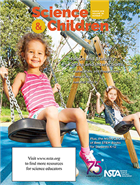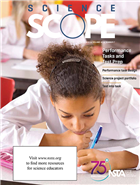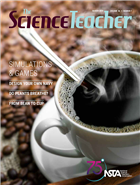Ideas and inspiration from NSTA’s March 2019 K-12 journals
By Mary Bigelow
Posted on 2019-03-14
Regardless of what grade level or subject you teach, check out all three K-12 journals. As you skim through titles and descriptions of the articles, you may find ideas for lessons that would be interesting for your students, the inspiration to adapt a lesson to your grade level or subject, or the challenge to create/share your own lessons and ideas. Click on the links to read or add to your library.
The lessons described in the articles include a chart showing connections with the NGSS. The graphics are especially helpful in understanding the activities and in providing ideas for your own investigations.
NSTA members have access to the articles in all journals, including the Journal of College Science Teaching.
 Science & Children – Motion and Stability: Forces and Interactions
Science & Children – Motion and Stability: Forces and Interactions
There may be teachers who are comfortable with life science investigations but apprehensive about physical science ones. This issue has ideas and lessons to explore concepts related to forces and motion – topics students (and teachers) will enjoy!
Editor’s Note: Teaching Forces and Motion “Allowing time for children to explore helps them build early understandings of force and motion. Students can take ownership of planning and carrying out their own investigations about motion, and through careful observation of outcomes, students can recognize patterns, evaluate cause-and-effect relationships, and begin to explore stability and change within a system…So, let’s get the marbles rolling and bring on the pushing and pulling in the classroom as we learn about forces and interactions.”
Many authors share resources related to the lessons and strategies in their articles. These resources include rubrics, graphic organizers, handouts, diagrams, lists of resources, and complete lessons. You can access these through the Connections link for Science & Children.
- “Because magnetism seems unexplainable and magical, exploring magnetism helps children understand the nature of science.” The Early Years: Exploring Magnetism includes a discussion of how to introduce the concept in an age-appropriate way, along with a lesson which students design and build a structure that uses magnetic forces.
- Teaching Through Trade Books: Interacting With Forces focuses on “different types of interactions between objects and ask students to consider what happens when a force is applied to an object. Does it stop? Does it change direction? Which force is stronger? How does gravity affect the object?” The article has suggested books and lessons How Does It Move (K-2) and Identifying Gravity (3-5).
- The author of Tech Talk: Motion and Stability: Forces and Interactions states that “Pairing technology-rich experiences that simulate natural phenomena with actual hands-on learning in the real world is an effective way to use technology for science learning… Well-crafted simulation apps give students the opportunity to work in simulated real-world conditions. They also enable students to manipulate interactions with natural phenomena while getting feedback on their decisions.” There are descriptions of two such apps.
- Ramp It Up! reinforces the Tech Talk article. “Digital tools, such as the digital journal described in this article, can allow children to closely observe, document, review, and make sense of phenomena that occur slowly (e.g., plant growth) or, in the case of ramp investigations, phenomena that occur quickly.” The article has numerous photos of students engaged in their study of ramps and balls.
- Just Roll With It focuses on how changing the surface and the height of the ramp affects the motion of a marble. Students learn the concepts of independent and dependent variables, prediction, and data collecting. Formative Assessment Probes: Describing the Motion of a Marble could help teachers ascertain what students know (or think they know) about the concept.
- Fraught With Friction poses a question about how far a toy vehicle would travel on different surfaces. Students addressed the question using the PEOE strategy (predict, explain, observe, explain). The authors note that “Because we asked students for their predictions before conducting the investigation, they thought more about the activity and were more actively engaged during it to find out whether their predictions matched their observations.” Perhaps this lesson could be supplemented with The Poetry of Science: Poetry in Motion.
- Play takes on a new meaning as students combine play and learning. With traditional tops (which students may not be familiar with) and fidget spinners, students can investigate forces and motion. Engineering Spinners includes a lesson in which students designed their own versions of these toys. Pushes, Pulls, and Playgrounds demonstrates how playgrounds can do double duty as recreation and as a place to investigate forces and motion. Nonfiction texts add to the information and students’ vocabulary.
- See how students go beyond “activitymania.” In Engineering Encounters: Balancing Engineering and Science Instruction, students solve an engineering challenge to move an object from the floor to the table, as they learn about balanced and unbalanced forces.
These monthly columns continue to provide background knowledge and classroom ideas:
- Methods and Strategies: Scaffolding for Failure “Design failure is neither rare nor something to be avoided as students engage in science-integrated engineering design challenges as a part of the Next Generation Science Standards”
- Teaching Teachers: Evolving the Physics Mindset “Science is a foreign language to many adults, including teachers. Just as a teacher would not be expected to teach German to students if they do not speak the language, we cannot expect teachers to teach science if they do not fully know its ideas.”
- Science 101: What’s Wrong With “For Every Action, There is an Equal and Opposite Reaction”? “Whenever one object exerts a force on a second object, the second object exerts a force of equal magnitude and in the opposite direction on the first object.”
For more on the content that provides a context for projects and strategies described in this issue, see the SciLinks topics Electric Current, Engineering Structures, Forces, Forces and Motion, Friction, Gravity, Inertia, Magnets, Newton’s Laws of Motion, Simple Machines
Continue for this month’s Science Scope and The Science Teacher.
 Science Scope – Performance Tasks and Test Prep
Science Scope – Performance Tasks and Test Prep
From the Editor’s Desk: Assessing Performance Expectations “A performance task is an excellent assessment vehicle because it allows students to demonstrate their knowledge, understanding, and proficiency through a product or performance, rather than with a traditional objective test.” If your state uses a traditional test format, however, the author has suggestions for helping students cope.
Articles in this issue that describe lessons (many of which use the 5E model) include a helpful sidebar documenting the big idea, essential pre-knowledge, time, safety issues, and cost. The lessons also include connections with the NGSS.
Many authors share resources related to the lessons and strategies in their articles. These resources include rubrics, graphic organizers, handouts, diagrams, lists of resources, and complete lessons. You can access these through the Connections link for Science Scope.
- How to Design a Performance Task describes a process to develop performance tasks based on NGSS performance expectations: unpack the expectation, identify an phenomenon, develop prompts, create rubrics or scoring guides, and pilot/revise. “As you prepare to make the shift to NGSS-designed performance tasks, we highly recommend you put together a team of forward-thinking teachers like yourself, and seek out professional development to guide you through this new process.” [Good advice!]
- Turning Tests Into Tasks has a step-by-step “scaffold” to help teachers design performance assessments based on standardized test questions. The two examples are summarized as graphic organizers that reflect and demystify the process.
- Practical Research: How Can Middle School Science Fairs Help Students Meet Science Standards? summarizes research on science fairs, specifically on the strategies teachers use to support students and the effect on the development of science and engineering practices.
- The Science Project Portfolio breaks down what could be formidable task for middle school students into a series of smaller, well-defined assignments, culminating in a final presentation.
- Making in the Middle: Making as a Performance Task illustrates how a traditional unit was transformed into a maker-centered project, in which students spent time gathering information, creating models, and presenting their work. The article includes examples and suggestions.
- In Ride the Movies, students create models or prototypes of amusement park rides based on ideas from movies to assess their understanding of forces, motion, energy transfers, and other physical science concepts. The authors include planning guidelines and photos of student creations.
- Students can participate in a project to analyze data related to Alzheimer’s disease with Citizen Science: Game for the Good With Stall Catchers Citizen Science
- A teacher describes the process she uses to create performance assessments in Teacher to Teacher: Three-Dimensional Classroom Assessment Strategies. Examples are provided, too.
- If your students have to take a standardized test, check out Science for All: Crosscutting Test Prep Strategies. “In our minds, test prep is about organically teaching students comprehension, self-monitoring, and problem-solving strategies through engaging instructional activities.”
- A concept sort as a performance task “provides a safe and engaging activity where students can showcase prior knowledge, scaffold new learning, and demonstrate acquired knowledge. Teacher’s Toolkit: So Many Words, So Little Time has several examples and an in-depth rationale for using concept sorts.
These monthly columns continue to provide background knowledge and classroom ideas:
- Disequilibrium: Polymers has a 5E lesson with “a fun activity that will help students gain a better understanding of the role polymers play in the functioning of designed materials.”
- Scope on the Skies: Occultations and Eclipses “In astronomy, an occultation occurs when something between you and a distant object blocks your view of that distant object…Every month, our Moon and asteroids are usually involved with occultations and conjunctions, often with the same stars and planets on a regular basis.”
- Interdisciplinary Ideas: Teaching Nonfiction Text Structure includes tables summarizing and illustrating nonfiction text features and structures: description, sequence, compare/contrast, cause/effect, problem/solution.
For more on the content that provides a context for projects and strategies described in this issue, see the SciLinks topics Alzheimer’s, Atmosphere, Catapults, Cell Structure, Chemical Reactions, Eclipses, Energy Transfer, Microgravity, Newton’s Laws of Motion, Organelle, Polymers, Populations and Communities, Water Cycle
 The Science Teacher – Simulations & Games
The Science Teacher – Simulations & Games
Explore this issue to find out why a cup of coffee is featured on the cover!
Editor’s Corner: More than a Game “Scientists use simulations to make the invisible visible, answer questions, test ideas, and make predictions. Engineers use simulations to test the safety and performance of engineering solutions. Simulations help us understand dynamic, complex systems like weather and climate, rush hour traffic, ecosystem dynamics, group behavior, and much more.”
Many authors share resources related to the lessons and strategies in their articles. These resources include rubrics, graphic organizers, handouts, diagrams, lists of resources, and complete lessons. You can access these through the Connections link for The Science Teacher.
- Design Your Own Navy with an online simulator. Students apply what they have learned to “design and use ships for various naval missions by mastering scientific concepts such as force, energy, and work, while employing an engineering design process.” Students work in teams as engineers in the design process and as crew members in the mission challenge.
- Do Plants Breathe? addresses the misconception that plants engage in photosynthesis but not cellular respiration, using an online simulation.
- The processes of roasting, grinding, and brewing coffee are opportunities for learning science concepts, as featured in From Bean to Cup.
- The author of Spicing Up Your Classroom With Games lists three categories of classroom games: “active games that spice up review of content already covered, simulations that personalize content, and adaptation of commercially produced games to increase depth of content knowledge.” Classroom examples of each are provided.
- Teaching With Simulations includes a table that describes how the strategies used in simulations correlate with the NGSS science and engineering practices. Using the PhET simulations as a context, the authors offer suggestions on using simulations in instruction.
These monthly columns continue to provide background knowledge and classroom ideas:
- Career of the Month: An Interview With Atmospheric Scientist Shawn Urbanski “I decided that I wanted a career that involved both meteorology and chemistry.”
- Right to the Source: Envisioning the Possibilities of Educational Gaming with Carl Sagan has a link to look at Sagan’s ideas for a video game related to astronomy in the Library of Congress.
- Focus on Physics: Quickly Teaching Speed, Velocity, and Acceleration—Part 2 “One of the great things about being a physics teacher is the relevance of your study of nature’s rules.”
For more on the content that provides a context for projects and strategies described in this issue, see the SciLinks topics Acceleration, Atmosphere, Climate Change, Energy, Energy Transformations, Forces and Motion, Galaxies, Ozone, Photosynthesis, Physical/Chemical Change, Respiration, Speed, Velocity
Disclaimer: The views expressed in this blog post are those of the author(s) and do not necessarily reflect the official position of the National Science Teaching Association (NSTA).

